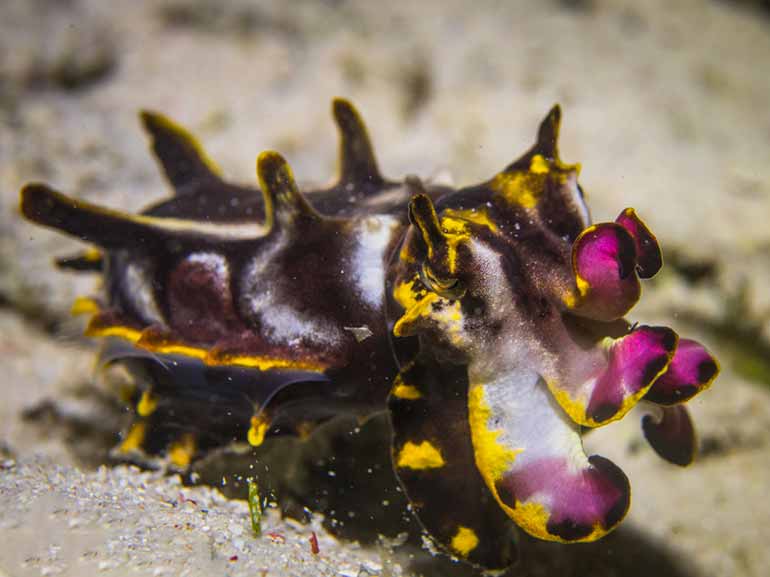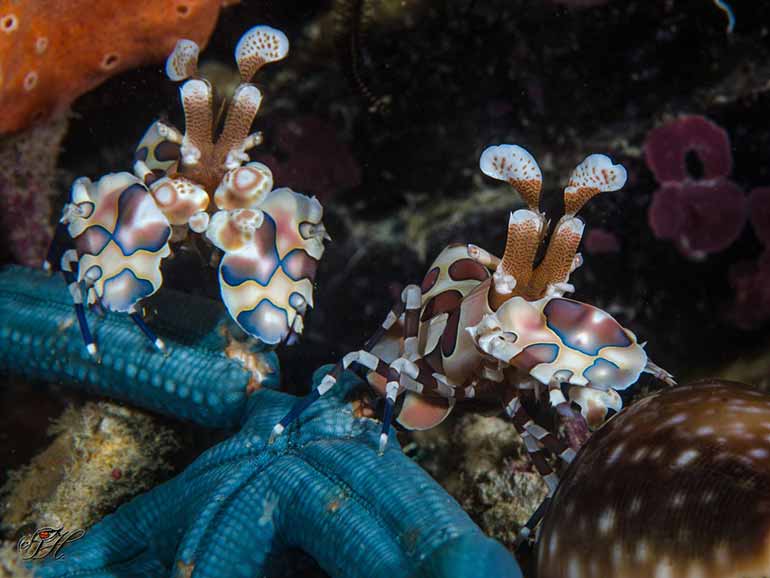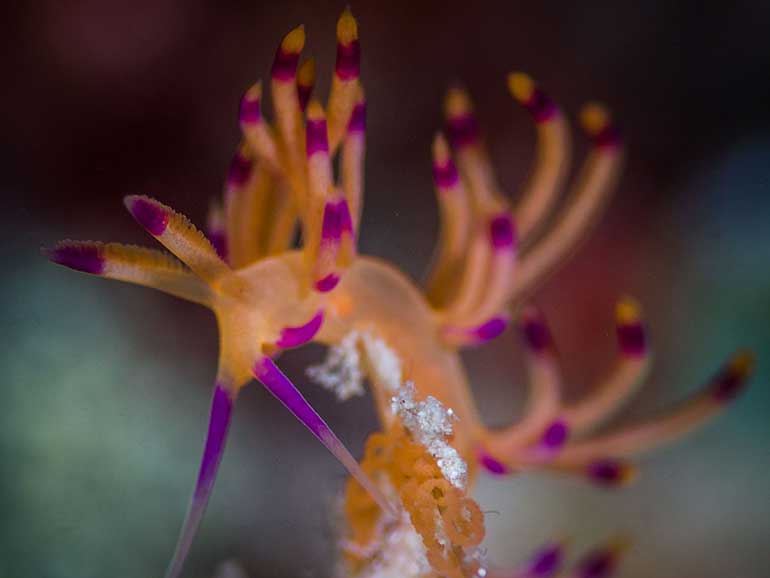
If you thought diving was all about crystal clear visibility, stunning coral reefs, schooling fish, sharks, rays, and turtles – you’d be right! But only partly. Today we’ll introduce you into a different type of diving, called “muck diving”.
Whilst the name doesn’t sound very enticing, muck diving can be one of the most rewarding forms of diving. It refers to diving in muddy conditions on sandy or silty bottom dive sites, in the search for small, bizarre-looking creatures. In comparison to colourful coral reef dives, a muck diving site may look dull or empty at first sight, but we can ensure you that this is NOT the case! There is such a diversity of marine life to be found on these dive sites, and they are anything but boring!
Many of the critters you’ll see have developed some impressive skills and features to help them live in the muck. You’ll get to see both extraordinary camouflage and mimicry skills, as well as flashes of vivid colours used to threaten potential predators. Muck diving may be a completely different diving experience than what you are used to, and you’ll be challenged to really slow down and zoom in!
You can expect to see some incredibly weird and wonderful creatures hiding in the muck, many of which are super rare and very well camouflaged. Your dives will turn in to treasure hunts, and the treasures to be found around Mabul are well worth the effort!

Mabul Island is one of the richest dive spots in the world for rare small critters, with diversity rivalling muck diving meccas such as Indonesia’s Lembeh and Philippine’s’ Anilao.
Flamboyant cuttlefish, blue-ringed octopus, stargazers, seahorses, all types of frogfish and ghost pipefishes are just a few of the crazy critters to be found around Mabul! The dive sites around Mabul range from sloping coral reefs, to sandy slopes, seagrass beds, jetty dives, artificial reefs and everything in between.
Together with its proximity to world-famous Sipadan Island, Mabul certainly offers one of the best well-rounded dive holidays you can find in Asia, if not the world!

Cephalopods are some of our favourite critters to search for, and lucky for us, there’s no shortage of them around Mabul! The flashing colours of the elusive flamboyant cuttlefish and blue-ringed octopus will leave you in awe, scrambling for your camera. With a bit of luck you may spot the elusive mimic octopus, a true master of disguise known for its ability to mimic other types of marine life. If you decide to brave the dark and embark on a night dive you’ll be in for a treat with regular appearances of bobtail squid, Papuan cuttlefish, coconut octopus and two-tone pygmy squid amongst others!

There are approximately 50 species of frogfish out there, many which can be found in this area. They may not win any awards for their good looks, but oh how much we love them still! Frogfish are masters of camouflage and many can change their colour to match their surroundings. They spend most of their time moving as little as possible, blending in with the environment, but make no mistake – when they do move, they are FAST! Frogfish have one of the fastest attacks in the animal kingdom, it can be as quick as just a few milliseconds! Blink and you’ll miss it!

The list of Mabul’s crustaceans is loooong and it would be near impossible to list them all out, but some of our favourites include the harlequin shrimp, orangutan crab, peacock mantis shrimp, tiger shrimp, candy crab, hairy squat lobster, zebra crab, hairy shrimp, spider crab, coleman shrimp, bumblebee shrimp and skeleton shrimp. Phew! We could go on and on, the list is endless!

Hunting for nudibranchs is highly addictive… It could be a sport of its own, and Mabul would definitely one of the best places in the world to do it! It’s not uncommon to see over 20 different species in just one dive, all different in shape, size and colour. Nudibranchs get their bright colours from the food that they eat, and these may be used either for camouflage or to warn predators that they are poisonous! Nudis make for fantastic photograph subjects as they are generally slow moving, with stunning colours on display.

If there was ever a competition for the worlds pretties fish, the mandarin fish would definitely rank pretty high, with its’ ornate patters and stunning colours! At sunset they put on a show to be remembered for anyone lucky enough to see it. They perform one of nature’s most incredible mating rituals, or “mating dance”. To the non-initiated it may seem like strange behavior to travel across the world just to watch two tiny fish doing X-rated performances, but we promise it is a sensational experience and perfectly normal diving behavior… 😉

From pygmy seahorses, pipefish, ghost pipefish and pipe horses there’s no lack of these guys around Mabul! Look in and around feather stars for the ornate ghost pipefish, or on the sandy seagrass bed for robust and slender ghost pipefish. Pygmy seahorses hide amongst the polyps of same coloured gorgonian fans. There’s an abundance of stick pipefish, banded pipefish, reeftop pipefish and winged pipefish – and with a bit of luck you may find a velvet ghost pipefish or a halimeda ghost pipefish too!

In diving terms, if it’s hairy it’s AWESOME! Yep that’s right, and the more hair the better! Hairy octopus, hairy frogfish, hairy shrimp, hairy squat lobsters. All of the above are rare and highly sought after creatures amongst divers and many would travel great distances to get a glimpse of a hairy octopus, or to get that perfect shot of a hairy frogfish.

Located right in front of the Scuba Junkie jetty, our house reef is one of THE best dive sites around Mabul. If you ask our staff members about their favourite dive sites, many place AWAS very high on their list! An excellent sandy slope dive site known especially for its regular encounters with the elusive flamboyant cuttlefish. Other gems to look out for are different types of ghost pipefish, frogfish, fingered dragonets, flying gurnards, snake eels, nudibranchs and mandarin fish! 60 minutes just doesn’t seem like enough time to explore everything AWAS has to offer, and in fact many divers want to repeat it more than once!

Including both a sandy slope with a few sunken boats, as well as a shallow sloping reef this is a great dive site for those who wish to have a bit of a mix of everything. You’ll see plenty of the typical muck diving critters along the sandy bottom, as well as a healthy amount of fish life attracted by the wrecks. You can then finish off the dive and perform your safety stop gently drifting along the coral reef. A healthy mix of all good things! This is a great dive site in particular to spot the ornate ghost pipefish, and different types of frogfish!

Just around the corner from our Mabul Beach Resort is the dive site Artificial Reef, a large sandy area with lots of man-made structures. It’s an awesome place to really slow down and zoom in. You’ll find an abundance of different crustaceans, cephalopods and pipefish. Chances are high you’ll see a frogfish or two, and there are colourful nudibranchs dotted along each and every structure.

Whilst the rig may be a bit of an eye sore on the horizon, the marine life you’ll find underneath is spectacular. It’s a playground of reef and sandy patches, artificial structures and some stretches of rubble. It might not be the prettiest dive site, but we can ensure that you could fill more than just the one page of your log book after this dive. Look out for pygmy seahorses, blue-ringed octopus and frogfish smaller than your fingernail!

In general, the slower you go – the better! A muck dive is not the time and place to rush, and when you take it slow you’ll see so much more marine life. Be patient and you will be rewarded! Many of the critters you are searching for are either quite small OR very camouflaged – if you speed across the dive site you will definitely miss a lot of cool stuff!
Diving over a sandy or silty bottom requires good buoyancy control! Keeping your hands, fins, and equipment off the bottom is essential to avoid stirring up silt from the bottom - reducing the visibility. You’ll also want to avoid disturbing the environment and the animals hiding in it.
An experienced dive guide can make or break your dive! A good dive guide will know the local environment, the best places to find certain critters, and sometimes it seems they can conjure amazing critters out of seemingly nowhere!
This is a good tip for diving in general, but especially so for muck diving! Many of the sought after critters live in very specific environments and habitats. A certain animal may prefer a special habitat, and some you can only find on just ONE type of coral! Knowing where to look is imperative!
Again this can be applied to all types of diving. Respect the marine life and you’ll find you have longer lasting and better underwater encounters. When you find a critter, try your best to keep a respectful distance as to not spook or disturb them. Never touch or move critters for the sake of a better photograph!
At first glance, you may wonder what all the fuss is about when you descend on a seemingly “empty” dive site, with little to no coral around – but give it a chance and you’ll be pleasantly surprised! You’ll likely spend most of the dive with your nose just inches from the ground, combing through the dive site, and you’ll be surprised by how just how many critters you can cross off your wish list!

Hopefully we’ve given you a bit of an insight to this different style of diving and why muck diving is so incredible. Diving doesn’t have to be all about coral reefs and big species! Give it a go on your next dive holiday, and before you know it you might find yourself becoming a muck-diving addict!
What better place to discover it than Mabul Island, a world renowned muck diving Mecca? Check out our dive packages here, the best way to explore Sipadan, Mabul and the surrounding islands!

